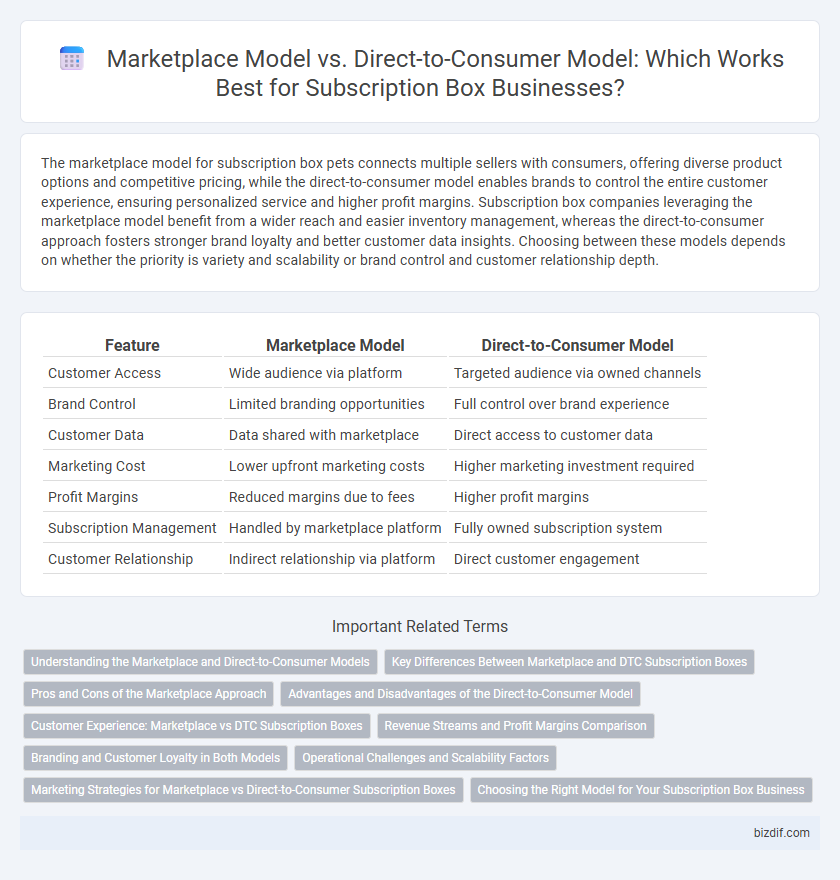The marketplace model for subscription box pets connects multiple sellers with consumers, offering diverse product options and competitive pricing, while the direct-to-consumer model enables brands to control the entire customer experience, ensuring personalized service and higher profit margins. Subscription box companies leveraging the marketplace model benefit from a wider reach and easier inventory management, whereas the direct-to-consumer approach fosters stronger brand loyalty and better customer data insights. Choosing between these models depends on whether the priority is variety and scalability or brand control and customer relationship depth.
Table of Comparison
| Feature | Marketplace Model | Direct-to-Consumer Model |
|---|---|---|
| Customer Access | Wide audience via platform | Targeted audience via owned channels |
| Brand Control | Limited branding opportunities | Full control over brand experience |
| Customer Data | Data shared with marketplace | Direct access to customer data |
| Marketing Cost | Lower upfront marketing costs | Higher marketing investment required |
| Profit Margins | Reduced margins due to fees | Higher profit margins |
| Subscription Management | Handled by marketplace platform | Fully owned subscription system |
| Customer Relationship | Indirect relationship via platform | Direct customer engagement |
Understanding the Marketplace and Direct-to-Consumer Models
The marketplace model aggregates multiple subscription box brands on a single platform, offering consumers variety and convenience while enabling brands to reach a broader audience with lower marketing costs. In contrast, the direct-to-consumer model allows subscription box companies to manage all aspects of customer experience, from personalization to fulfillment, fostering stronger brand loyalty and higher profit margins. Analyzing customer acquisition costs, control over branding, and data ownership reveals significant trade-offs between expanded reach in marketplaces versus deeper customer relationships in direct-to-consumer channels.
Key Differences Between Marketplace and DTC Subscription Boxes
Marketplace subscription boxes aggregate products from multiple sellers within a single platform, offering diverse selections but often at the cost of less brand control and customer data ownership. Direct-to-consumer (DTC) subscription boxes provide brands with full control over product curation, pricing, and customer relationships, enabling personalized marketing strategies and enhanced brand loyalty. The key differences lie in marketplace boxes leveraging third-party exposure and logistics versus DTC models emphasizing brand consistency, customer insights, and direct engagement.
Pros and Cons of the Marketplace Approach
The marketplace model in subscription boxes offers broad product variety and access to multiple brands within a single platform, enhancing customer convenience and discovery. However, it often entails higher fees and reduced control over brand presentation and customer data, which can limit personalized marketing and margin optimization. This contrasts with direct-to-consumer models that prioritize brand control and customer relationship management but may require greater investment in customer acquisition.
Advantages and Disadvantages of the Direct-to-Consumer Model
The Direct-to-Consumer (DTC) model allows brands to maintain full control over customer experience, data, and branding, resulting in higher profit margins and personalized marketing opportunities. However, DTC requires substantial investment in logistics, customer acquisition, and fulfillment infrastructure, which can increase operational complexity and costs. Limited marketplace exposure means brands must independently drive traffic and sales, posing scalability challenges compared to marketplace models.
Customer Experience: Marketplace vs DTC Subscription Boxes
Marketplace subscription boxes offer diverse product selections from multiple brands, enhancing variety and discovery for customers but may introduce inconsistencies in packaging and delivery times. Direct-to-consumer (DTC) subscription boxes provide a more personalized and cohesive customer experience, ensuring consistent quality control and streamlined communication. The choice between marketplace and DTC models impacts factors like brand loyalty, customer service responsiveness, and overall satisfaction in subscription box services.
Revenue Streams and Profit Margins Comparison
The marketplace model generates revenue through transaction fees and commissions, often resulting in lower profit margins due to shared earnings with multiple sellers. The direct-to-consumer (DTC) model captures full retail prices, enabling higher profit margins by eliminating intermediaries and fostering stronger customer relationships. Subscription box businesses leveraging the DTC model benefit from predictable, recurring revenue streams, contrasting with the variable income typical in marketplace setups.
Branding and Customer Loyalty in Both Models
The marketplace model offers exposure to a broader audience but often dilutes individual brand identity, making it challenging to build strong customer loyalty. In contrast, the direct-to-consumer model allows brands to maintain full control over branding and customer interactions, fostering deeper loyalty through personalized experiences and consistent messaging. Subscription box companies leveraging the direct-to-consumer approach benefit from higher repeat purchase rates and stronger brand advocacy.
Operational Challenges and Scalability Factors
The Marketplace model faces operational challenges such as managing multiple vendors, ensuring consistent product quality, and handling complex logistics, which complicate scalability due to dependency on third-party sellers' performance and inventory. In contrast, the Direct-to-Consumer model simplifies operations by controlling the entire supply chain, enabling faster decision-making and streamlined inventory management, which enhances scalability through direct customer relationships and data-driven marketing. Scalability in the Direct-to-Consumer model benefits from predictable demand patterns and the ability to customize offerings, while the Marketplace model risks bottlenecks from vendor variability and platform maintenance demands.
Marketing Strategies for Marketplace vs Direct-to-Consumer Subscription Boxes
Marketplace subscription box brands leverage broad digital advertising and SEO strategies to attract diverse audiences through platform visibility and user reviews. Direct-to-consumer subscription boxes prioritize personalized email campaigns, social media engagement, and influencer partnerships to build strong brand loyalty and direct customer relationships. Marketplace models benefit from aggregated traffic and cross-promotion, while direct-to-consumer models focus on data-driven targeting and tailored customer experiences.
Choosing the Right Model for Your Subscription Box Business
Selecting the right model for your subscription box business depends on factors like control, customer data access, and brand experience. The marketplace model offers broader audience reach and simplified logistics but limits direct customer interaction and data ownership. In contrast, the direct-to-consumer model provides full control over branding, personalized customer engagement, and valuable data insights, essential for building long-term customer loyalty.
Marketplace model vs Direct-to-consumer model Infographic

 bizdif.com
bizdif.com